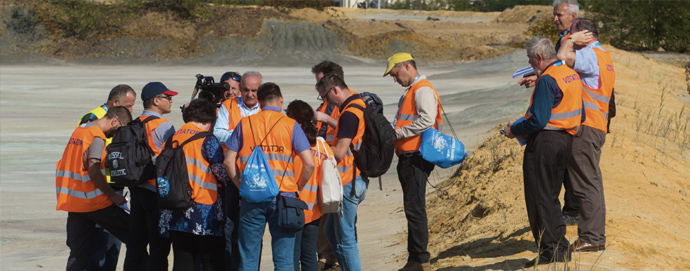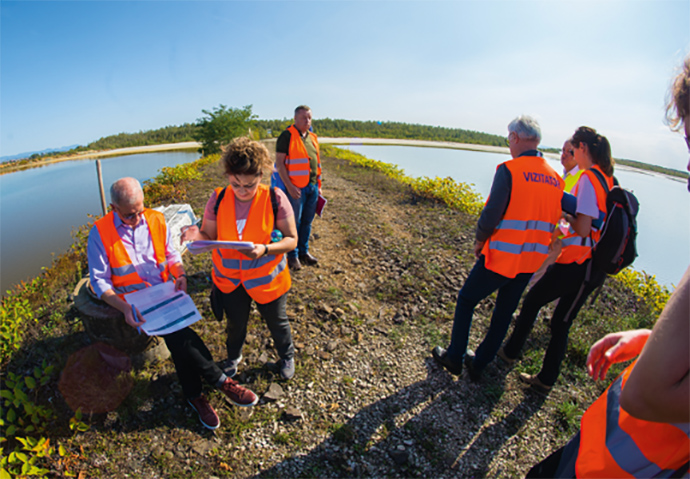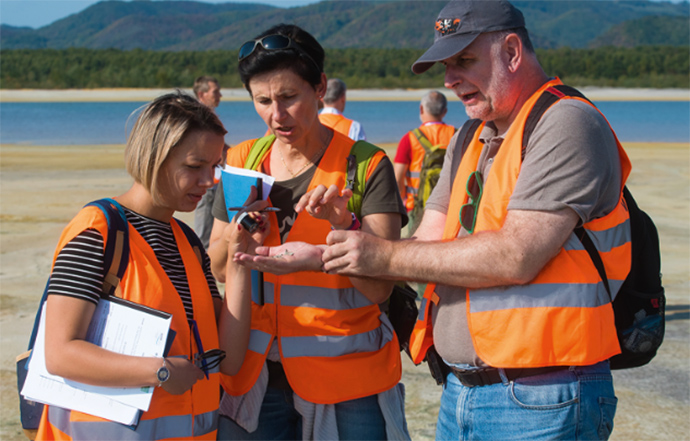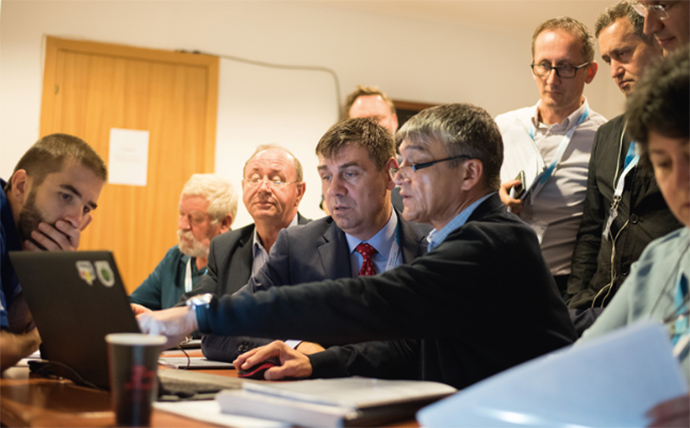Danube Watch 3/2021 - The Danube TMF Project
The Danube TMF Project
Towards sustainable management of the mining tailings storage facilities in the Danube River Basin

Mining is one of the most traditional and historically relevant industrial sectors in the world, providing valuable ores and minerals for further processing. Nowadays it is becoming even more important, as with the spread of smart and advanced technologies, a steep rise of connected mining activities is expected. However, mining also represents a significant waste stream generated by its operations. The safe long-term management of the fine-grained mineral processing waste needs to be ensured in appropriately designed, operated and maintained storage facilities.
The Problem
The dramatic accidents in the last two decades worldwide but also in the Danube River Basin (DRB) have shown that failures of Tailings Management Facilities (TMFs) can lead to major catastrophes for both human health and environment. TMFs are storage facilities for the so-called tailings, the fine-grained waste material derived from a mining processing plant. Tailings represent unrecoverable and uneconomic minerals, metals, chemicals and organic materials and are frequently transported by hydraulic methods to and deposited and handled at TMFs in the form of slurry. Due to the physical characteristics and/or chemical nature of substances that can be found in the tailings, but also due to the significant amounts that need to be stored, TMFs pose a risk to the surrounding environment, population and economic values. Although their safety conditions have been significantly improved over recent last decades in many countries thanks to strict requirements and respective measures, the safety of a number of TMFs is still lower than expected, especially due to economic constraints and lack of management capacity.

Furthermore, a steep increase in mining activities over the next decades is expected, including an increase in the number of TMFs, as smart and advanced technologies will force a dramatic rise in demand for specific metals like cobalt, copper, lithium and nickel. Thus, society may also have to face an increasing risk of TMF failures with potential casualties and ecological damages if TMF safety is not managed appropriately, i.e., in compliance with standards and taking climate change impacts into account. The potential consequences of TMF disasters may have significant cost implications and the post-accident costs to be paid for rehabilitation and remediation are usually much higher than those of the preventive safety measures.
Situation in the DRB
More than 300 TMFs are located in the DRB, for which adequate safety conditions and measures have to be put in place. About 25% of these sites are associated with high accident hazard due to large amounts of hazardous substances stored in tailing ponds. Another 25% of the TMFs are considered as high-risk accident hotspots where TMFs with significant hazard are located close to densely populated areas and/or a major water body. Past accidents at Baia Mare (Romania) in 2000 and Ajka (Hungary) in 2010 dramatically demonstrated how serious the impacts of inappropriate TMF operation might be on people, environment and water resources. These events call for the development and implementation of consistent and harmonised management strategies, practical safety assessment tools and suitable safety measures complying with a minimum set of standards throughout the DRB. The ICPDR, being the organisation in charge of transboundary water management in the DRB, has been dealing with accident prevention and control including disaster events related to TMFs since its establishment.

The Danube TMF Project
Recognising the importance of the issue, the ICPDR implemented the Danube TMF Project in 2019-2020 to help Danube countries cope with these challenges and improve safety conditions of the TMFs. The project was financed by the Advisory Assistance Programme of the German Federal Ministry for the Environment, Nature Conservation and Nuclear Safety and was supervised by the German Environment Agency (UBA). The overall objective of the project was to contribute to strengthening the technical and management capacity at the concerned facilities and responsible authorities by providing them with practical tools for self-assessment and inspection, respectively. This will ensure that in the medium term a common set of minimum standards and safety requirements are respected in the DRB and the population and water bodies are protected.
Within the framework of former pilot projects of UBA, a TMF-Methodology was worked out to support regional and local assessment of TMF safety. It builds on the UNECE TMF Safety Guidelines, turning it into practical tools. The methodology comprises an index-based evaluation of the hazard potential for a large number of TMFs, the so-called Tailings Hazard Index (THI), and a detailed checklist for the safety analysis of individual TMFs. Building on the strengths of the methodology but also improving and adapting it based on up-to-date technical knowledge and best available techniques (BAT), Danube countries are provided with a set of practical tools to improve safety conditions of TMFs and to strengthen the capacity of operators and authority inspectors.
The THI has already proved its usefulness in directing limited country resources (financial and personnel) to TMFs representing the highest hazard potential. The underlying criteria used for the THI approach have been improved by taking up the results of a historical TMF failure analysis. As the THI takes only hazard potential into account, the potential impacts of individual TMF failures posing different threats to the environment and population are not considered. This problem has been solved by defining a potential risk zone in the vicinity of a TMF based on the dimensions of previous accidents for assessing the environment (aquatic ecosystem) and the population at risk. The result of this approach turns the THI into the Tailings Risk Index (TRI), which is even better reflecting the most dangerous TMFs in one country with regard to the potentially affected population and environment.
A preliminary TMF inventory was developed for the DRB based on open access data and official national information. The inventory includes basic data and a preliminary THI assessment for each identified TMF. Moreover, the TRI method was also tested and applied to all TMFs in the DRB. The results are demonstrated by an interim TMF mapping for the Danube region, accompanied with respective hazard and risk assessments.
The checklist for operating TMFs was revised and updated to ensure good harmony with EU legislation and better adaptation to the DRB conditions. Moreover, the safety evaluation tool was amended to make it more suitable for practical purposes. The checklist revision and update were in line with the relevant technical reports, EU legislation and BAT Reference Document and were based on an on-site expert visit carried out at the Baia Mare TMF. Competent authorities, TMF operators, concerned stakeholders and the public in the DRB and beyond are encouraged to apply the updated methodology, which is intended to contribute towards limiting the number of accidents at TMFs and minimising the severity of their consequences for human health and the environment.
Added value of the project
The outcomes of the Danube TMF project provide practical tools for risk-based TMF prioritization and detailed safety assessments, which have been adapted to the conditions of the DRB and could therefore be applied in several countries. The project started paving the way towards a consistent TMF safety assessment methodology at both regional and facility level and its results offer a reliable concept and sound technical basis for follow-up national activities. The ICPDR highly recommends adopting these tools at national level in the DRB and encourages the Danube countries to establish national or regional capacity building programs and conduct regular training events for TMF safety management. Moreover, the outcomes served the elaboration of a recently published recommendation paper for the DRB that provides recommendations for the Danube countries at both the technical and policy-making level on how to improve the safety conditions of the TMFs located in the DRB. Based on the project outcomes, the ICPDR developed a public brochure to further raise awareness of the issue.

Importantly, the project provided valuable inputs to the development of the Danube River Basin Management Plan Update 2021, currently published by the ICPDR. The preliminary TMF inventory was completed and integrated into the ICPDR data system based on officially approved TMF data from all countries. This made it possible, first time ever, that the TMFs are included into the basin-wide pressure assessment by presenting the hazard and risk associated to the TMFs located in the basin. Moreover, the Joint Program of Measures includes recommendations on how to ensure adequate safety conditions at the TMFs. With this, Danube countries jointly committed themselves to prevent transboundary pollution of waters related to TMF disasters.
Future Outlook
Bearing in mind the high number of TMFs in the DRB that may cause accidents even if appropriate safety measures are in place, the ICPDR intends to keep the TMF issue high on its agenda. To further promote and capitalize the results of the Danube TMF Project in the DRB, strengthen the practical aspects and the sustainability of the provided tools and address additional important aspects such as disaster management and preparedness, the ICPDR, in cooperation with the EUSDR PA5 is willing to implement a follow-up project in the coming years.






